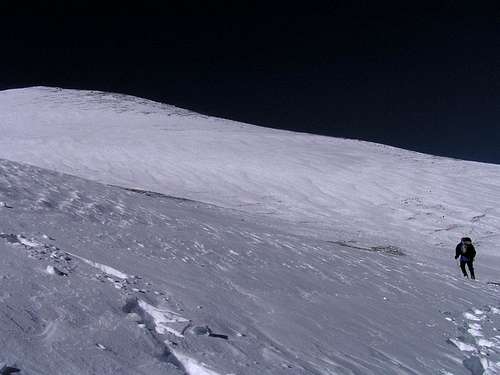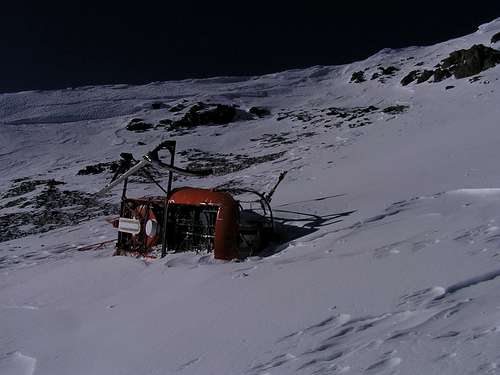I assess my situation. The winds are steady and strong. They pour up the long western slope, fresh from the Pacific only a hundred miles away. With nothing in their path to slow them, they pick up speed as they ascend, and, roaring with the sound of a hundred jet engines, shoot past me and over the brink. It’s awe-inspiring and a little scary. Never before has the wind seemed so thick, so tangible – it’s almost like honey flowing in reverse, uphill, at high speed. I can feel it pass around my body, viscous, real, yet completely oblivious to my presence. I am the intruder, here for only a moment; the wind, a full-time reality, lives here. I don’t.
A vision flashes into my brain. I see myself far up these slopes, hours later, struggling against ever-more-powerful winds, throat parched, dazed by the glare of the sun, too weak to summit. “No way!”, I decide, as I snap back to the only reality, the here and now. It is ten below zero Fahrenheit, the wind is blowing steadily at sixty miles per hour, with higher gusts. Welcome to Cerro Plata in the summer – I can’t imagine how much more difficult this climb would be in the winter. Fifty miles away to the northwest a giant white peak stands, its top bathed in the deep orange of the day’s first sunlight. It is Aconcagua, at almost 23,000 feet the highest peak in the southern and western hemispheres. The lower part of its incredible 10,000-foot south face is still hidden in deep shadow. Just looking at it makes me shiver.
I set off, trying to walk sideways into the wind while maintaining the proper direction. The slope is very gentle here, like an enormous parking lot, paved with crushed rock and tilted at ten degrees. The wind is relentless. I’m going to head for those rocks over there. I fuss continually with the hood of my down parka. The wind keeps pushing it into my line of sight. I give up, realizing there’s nothing to do but use one hand full-time just to hold it in place.
During this entire climb, I haven’t seen one living thing – no animals, birds or even plants. There’s nothing out on this slope to use to measure scale. I seem to walk forever before I reach the rocks. They turn out to be outcropping pillars thirty feet high. I’m tempted to rest in the lee of one of them, to just plain get out of the wind for a while, but I continue. The sun has now risen and bathes me in its light. My sunny side feels good, soaking up the life-giving warmth like a sponge. My shady side is cold and is in the direct blast of the icy wind. There are several rock-hard snowfields to cross. The glare while on them is intense, even with glacier glasses, forcing me to cinch the hood opening to fist-size. This must be what they mean by tunnel vision!
The summit and the northeast ridge of Cerro Plata in midsummer. This photo is used with the kind permission of Elias Segovia.
As I stop to catch my breath, I face north. I can see over the top of a 19,000-foot peak I climbed two days earlier. The world does not exist below 15,000 feet, where an unbroken sea of clouds stretches to the horizon. This is a glorious day. I know I’m going to make it. Everything is in my favor – even the wind has died down. Feeling rather smug, I continue up the easy, rocky slope. Then, without warning, an especially-strong gust of wind comes out of nowhere and hits me hard, knocking me flat on the ground. No damage done other than a few bruises to my ego. Instant karma – no smugness allowed here! I switch back into humble mode and carry on.
Usually, by mid-day, some pretty serious clouds build up in this area. Today, I’m spared. I feel pretty lucky. Sometimes up high the weather can sock in and it can snow for a week. It’s enough to ruin your whole day! Now I realize how well the weather has co-operated for me. I’ve been out here for fifteen days straight and I haven’t had to change my climbing plans once because of bad weather.
Breathing is, surprisingly, not too labored. I seem to be able to go steadily at about one step per breath. Now, I’m at 19,600 feet, the highest I’ve ever climbed. This is so exciting. Soon, the top of the second-highest peak of the range, at 20,014 feet, is level with me. A few more steps and I can see over it. Finally, after 29 years of climbing, I’ve broken the 20,000-foot barrier, which has always seemed psychologically important to me. It feels great!
A Lama helicopter on the slope of Cerro Plata at about 19,000 feet. Two military helicopter pilots were messing around on the mountain, likely in an attempt to set down and then take off again. One pilot set down and was unable to get the craft back off the ground. The helicopter subsequently developed mechanical problems and was temporarily abandoned. At that stage, it was in perfect condition, upright, had the rotors tied down and all of the windscreens covered. The military then flew a crew of mechanics up to the chopper to try and fix it. All of the mechanics were breathing bottled oxygen. The repairs did not go well and the helicopter was left over winter. Eventually, it slid downhill, turned over and was abandoned. This photo is used with the kind permission of Elias Segovia.
I skirt the edge of a beautiful blue glacier which fills a circular basin before spilling over into the valley below. This Andean ice is very hard, and glints in the light of the sun, now high overhead. Winds along its edges whip the spindrift into “snowdevils”, reminiscent of the dust devils I so often see in my desert home in Arizona. I check the altimeter. Wow, higher than McKinley! Truly a banner day.
The remaining distance to the summit is all open to view on the steep but easy slope ahead of me. The whole world drops away as I walk the last few snowy steps to the summit. Elated, but tired, I step on to the top. Cerro Plata, 20,710 feet. I’ve made it. I look at my watch for the first time since leaving the tent – eight hours have passed. The winds are punishing. I take the customary summit photos, only daring to remove my mitts for a few moments so my hands won’t freeze. Nineteen and twenty-thousand-foot peaks, many without names, fill all my field of view. Some of them seem like old friends, familiar through studying maps of this area, even though I’ve never set foot on them. Seeing giants like Tupungato is incredible, and now I’m really savoring the moment I’ve planned and worked towards for so long. I feel like a million bucks. The joy I’m feeling now is the reason I climb. Even so, there’s a limit to how long you can linger on a summit such as this, and, after fifteen minutes, I start down. It’s been a good day in the Cordón del Plata.
Note – this story was originally written shortly after I summited Cerro Plata in December of 1990. Back then, climbers from other countries, including myself, always felt that there was something screwy about the elevations that were shown on Argentine topographic maps for this area. In fact, the topographic maps of several South American countries showed elevations that were often called into question. Nowadays, most climbers carry a GPS unit with them, and this practice has shown that, in fact, elevations in the Cordón del Plata are somewhat lower than those I have indicated in this article. I simply wanted to present the story to you as it had originally been written. DM
Please check out our Facebook page at https://www.facebook.com/pages/Desert-Mountaineer/192730747542690


